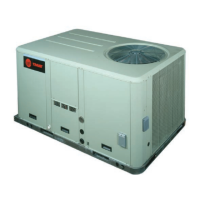Maintenance
RT-SVX21AC-EN 71
Coil Cleaning
Regular coil maintenance, including annual cleaning,
enhances the unit’s operating efficiency by minimizing:
compressor head pressure and amperage draw,
evaporator water carryover, fan brake horsepower due to
increase static pressure losses, airflow reduction.
At least once each year, or more often if the unit is located
in a “dirty” environment, clean the evaporator and
condenser coils using the instructions outlined below. Be
sure to follow these instructions as closely as possible to
avoid damaging the coils.
Note: Fo
r units equipped with hail guards
follow removal
procedure listed below.
Hail Guard Removal
• Unlatch hail guard.
• Pull the top of the hail guard outward until the fastener
studs are free of the
retaining nuts.
• Lift the hail guard from the lower retaining bracket and
set aside.
Microchannel (MCHE) Coils
Due to the soft material and thin walls of the MCHE coils,
the traditional field maintenance method recommended
for Round Tube Plate Fin (RTPF) coils does not apply to
microchannel coils.
Moreover, chemical cleaners are a risk factor to MCHE due
to the
material
of the coil. The manufacturer does not
recommend the use of chemical cleaners to clean
microchannel coils. Using chemical cleaners could lead to
warranty claims being further evaluated for validity and
failure analysis.
The recommended cleaning method for microchannel
condenser coils is
pressurized water or air with a non-
pinpoint nozzle and an ECU of at least 180 with pressure no
greater than 600 psi. To minimize the risk of coil damage,
approach the cleaning of the coil with the pressure washer
aimed perpendicular to the face of the coil during cleaning.
Note: Fo
r more details on Microchannel coil cleaning,
please refer to bulletin RT-SVB83*-EN.
Round Tube Plate Fin (RTPF) Coils
To clean refrigerant coils, use a soft brush and a sprayer
(either a garden pump-up type or a high-pressure
sprayer). A high-quality detergent is also required;
suggested brands include “SPREX A.C.”, “OAKITE 161”,
“OAKITE 166” and “COILOX”. If the detergent selected is
strongly alkaline (ph value exceeds 8.5), add an inhibitor.
1. Remove enough panels from the unit to gain access to
the coil.
2. Protect all electrical devices such as motors and
co
ntrollers
from any over spray.
3. Straighten any bent coil fins
with a fin comb.
4. Mix the detergent with water acc
ording to the
manufacturer’s instructions. If desired, heat the
solution BUT DO NOT EXCEED 150ºF maximum to
improve its cleansing capability.
5. Pour the cleaning solution into the sprayer. If a high-
pr
essure sprayer is used:
a. do not allow sprayer pressure to exceed 600 psi.
b. the minimum nozzle spray angle is 15 degrees.
c. maintain a minimum clearance of 6" between the
spr
ayer no
zzle and the coil.
d. spray the solution perpendicular (at 90 degrees) to
the coil face.
6. Spray the leaving-airflow side of
the coil first; then
spray the opposite side of the co
il. Allow the cleaning
solution to stand on the coil for five minutes.
7. Rinse both sides of the coil
with cool, clean
water.
8. Inspect both sides of the coil; if it still appears to be
dirty, re
peat Step 6 and Step 7.
9. Reinstall all of the components and panels removed in
Step 1 and any protective covers installed in Step 2.
Note: Fo
r units equipped with hail guards follow
reinstallation procedure listed below.
NOTICE
Coil Damage!
Failure to follow instructions below could result in coil
damage.
DO NOT use any detergents with microchannel
condenser coils. Use pressurized water or air ONLY,
with pressure no greater than 600psi.
For additional information regarding the proper
m
icrochannel coil cleaning procedure, refer to service
bulletin RT-SVB83*-EN.
WARNING
Hazardous Chemicals!
Failure to follow all safety instructions below could
result in death or serious injury. Coil cleaning agents
can be either acidic or highly alkaline and can burn
severely if contact with skin occurs. Handle chemical
carefully and avoid contact with skin. ALWAYS wear
Personal Protective Equipment (PPE) including goggles
or face shield, chemical resistant gloves, boots, apron
or suit as required. For personal safety refer to the
cleaning agent manufacturer’s Materials Safety Data
Sheet and follow all recommended safe handling
practices.
WARNING
Hazardous Pressures!
Failure to follow safety precautions below could result
in coil bursting, which could result in death or serious
injury. Coils contain refrigerant under pressure. When
cleaning coils, maintain coil cleaning solution
temperature under 150°F to avoid excessive pressure
in the coil.

